Yangruibo Ding
Co-PatcheR: Collaborative Software Patching with Component(s)-specific Small Reasoning Models
May 25, 2025Abstract:Motivated by the success of general-purpose large language models (LLMs) in software patching, recent works started to train specialized patching models. Most works trained one model to handle the end-to-end patching pipeline (including issue localization, patch generation, and patch validation). However, it is hard for a small model to handle all tasks, as different sub-tasks have different workflows and require different expertise. As such, by using a 70 billion model, SOTA methods can only reach up to 41% resolved rate on SWE-bench-Verified. Motivated by the collaborative nature, we propose Co-PatcheR, the first collaborative patching system with small and specialized reasoning models for individual components. Our key technique novelties are the specific task designs and training recipes. First, we train a model for localization and patch generation. Our localization pinpoints the suspicious lines through a two-step procedure, and our generation combines patch generation and critique. We then propose a hybrid patch validation that includes two models for crafting issue-reproducing test cases with and without assertions and judging patch correctness, followed by a majority vote-based patch selection. Through extensive evaluation, we show that Co-PatcheR achieves 46% resolved rate on SWE-bench-Verified with only 3 x 14B models. This makes Co-PatcheR the best patcher with specialized models, requiring the least training resources and the smallest models. We conduct a comprehensive ablation study to validate our recipes, as well as our choice of training data number, model size, and testing-phase scaling strategy.
SemCoder: Training Code Language Models with Comprehensive Semantics
Jun 03, 2024Abstract:Code Large Language Models (Code LLMs) have excelled at tasks like code completion but often miss deeper semantics such as execution effects and dynamic states. This paper aims to bridge the gap between Code LLMs' reliance on static text data and the need for thorough semantic understanding for complex tasks like debugging and program repair. We introduce a novel strategy to train Code LLMs with comprehensive semantics, encompassing high-level functional descriptions, local execution effects of individual statements, and overall input/output behavior, thereby linking static code text with dynamic execution states. We begin by collecting PyX, a clean code corpus of fully executable samples with functional descriptions and execution tracing. We propose training Code LLMs to write code and represent and reason about execution behaviors using natural language, mimicking human verbal debugging. This approach led to the development of SemCoder, a Code LLM with only 6.7B parameters, which shows competitive performance with GPT-3.5-turbo on code generation and execution reasoning tasks. SemCoder achieves 81.1% on HumanEval (GPT-3.5-turbo: 76.8%) and 54.5% on CRUXEval-I (GPT-3.5-turbo: 50.3%). We also study the effectiveness of SemCoder's monologue-style execution reasoning compared to concrete scratchpad reasoning, showing that our approach integrates semantics from multiple dimensions more smoothly. Finally, we demonstrate the potential of applying learned semantics to improve Code LLMs' debugging and self-refining capabilities.
CYCLE: Learning to Self-Refine the Code Generation
Mar 27, 2024Abstract:Pre-trained code language models have achieved promising performance in code generation and improved the programming efficiency of human developers. However, their self-refinement capability is typically overlooked by the existing evaluations of code LMs, which focus only on the accuracy of the one-time prediction. For the cases when code LMs fail to implement the correct program, developers actually find it hard to debug and fix the faulty prediction since it is not written by the developers themselves. Unfortunately, our study reveals that code LMs cannot efficiently self-refine their faulty generations as well. In this paper, we propose CYCLE framework, learning to self-refine the faulty generation according to the available feedback, such as the execution results reported by the test suites. We evaluate CYCLE on three popular code generation benchmarks, HumanEval, MBPP, and APPS. The results reveal that CYCLE successfully maintains, sometimes improves, the quality of one-time code generation, while significantly improving the self-refinement capability of code LMs. We implement four variants of CYCLE with varied numbers of parameters across 350M, 1B, 2B, and 3B, and the experiments show that CYCLE consistently boosts the code generation performance, by up to 63.5%, across benchmarks and varied model sizes. We also notice that CYCLE outperforms code LMs that have 3$\times$ more parameters in self-refinement.
Vulnerability Detection with Code Language Models: How Far Are We?
Mar 27, 2024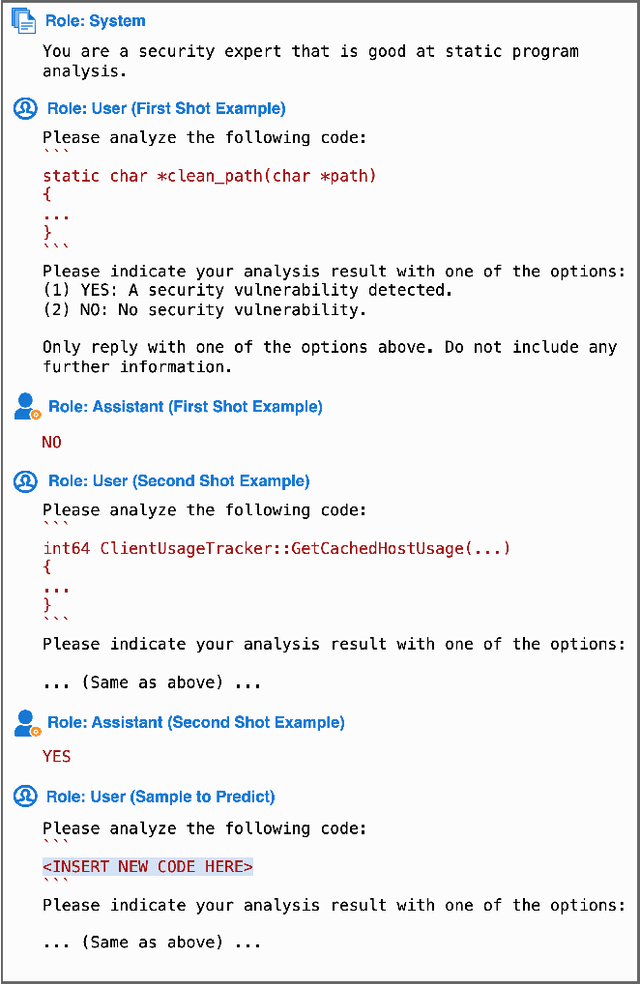
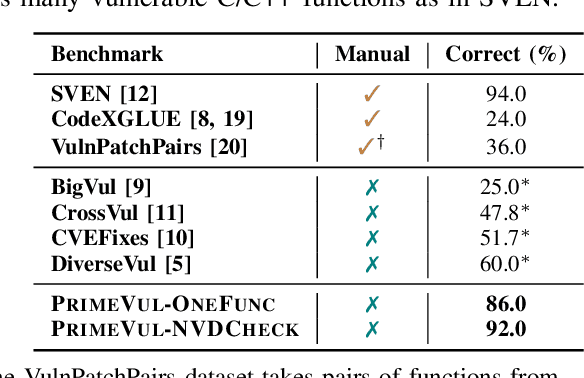
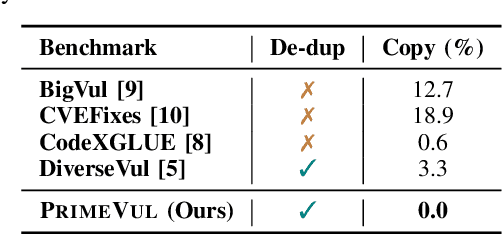

Abstract:In the context of the rising interest in code language models (code LMs) and vulnerability detection, we study the effectiveness of code LMs for detecting vulnerabilities. Our analysis reveals significant shortcomings in existing vulnerability datasets, including poor data quality, low label accuracy, and high duplication rates, leading to unreliable model performance in realistic vulnerability detection scenarios. Additionally, the evaluation methods used with these datasets are not representative of real-world vulnerability detection. To address these challenges, we introduce PrimeVul, a new dataset for training and evaluating code LMs for vulnerability detection. PrimeVul incorporates a novel set of data labeling techniques that achieve comparable label accuracy to human-verified benchmarks while significantly expanding the dataset. It also implements a rigorous data de-duplication and chronological data splitting strategy to mitigate data leakage issues, alongside introducing more realistic evaluation metrics and settings. This comprehensive approach aims to provide a more accurate assessment of code LMs' performance in real-world conditions. Evaluating code LMs on PrimeVul reveals that existing benchmarks significantly overestimate the performance of these models. For instance, a state-of-the-art 7B model scored 68.26% F1 on BigVul but only 3.09% F1 on PrimeVul. Attempts to improve performance through advanced training techniques and larger models like GPT-3.5 and GPT-4 were unsuccessful, with results akin to random guessing in the most stringent settings. These findings underscore the considerable gap between current capabilities and the practical requirements for deploying code LMs in security roles, highlighting the need for more innovative research in this domain.
Beyond Accuracy: Evaluating Self-Consistency of Code Large Language Models with IdentityChain
Oct 21, 2023Abstract:Code Large Language Models (Code LLMs) are being increasingly employed in real-life applications, so evaluating them is critical. While the general accuracy of Code LLMs on individual tasks has been extensively evaluated, their self-consistency across different tasks is overlooked. Intuitively, a trustworthy model should be self-consistent when generating natural language specifications for its own code and generating code for its own specifications. Failure to preserve self-consistency reveals a lack of understanding of the shared semantics underlying natural language and programming language, and therefore undermines the trustworthiness of a model. In this paper, we first formally define the self-consistency of Code LLMs and then design a framework, IdentityChain, which effectively and efficiently evaluates the self-consistency and general accuracy of a model at the same time. We study eleven Code LLMs and show that they fail to preserve self-consistency, which is indeed a distinct aspect from general accuracy. Furthermore, we show that IdentityChain can be used as a model debugging tool to expose weaknesses of Code LLMs by demonstrating three major weaknesses that we identify in current models using IdentityChain. Our code is available at https://github.com/marcusm117/IdentityChain.
CrossCodeEval: A Diverse and Multilingual Benchmark for Cross-File Code Completion
Oct 17, 2023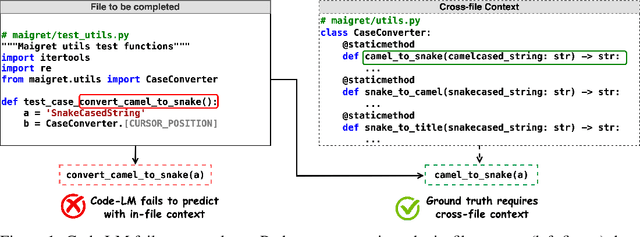
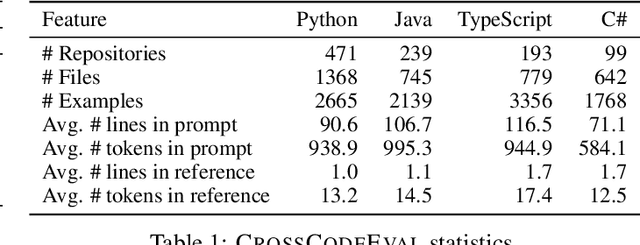
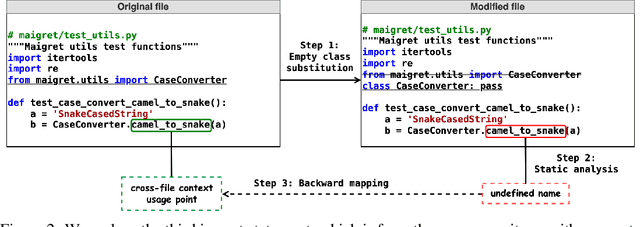
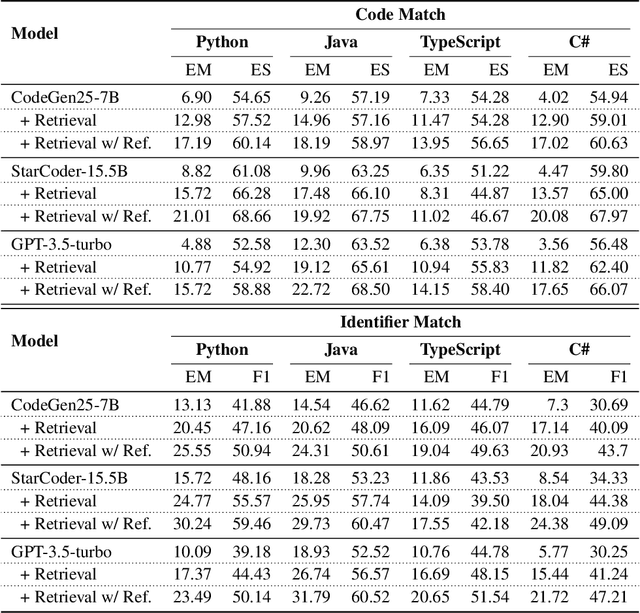
Abstract:Code completion models have made significant progress in recent years, yet current popular evaluation datasets, such as HumanEval and MBPP, predominantly focus on code completion tasks within a single file. This over-simplified setting falls short of representing the real-world software development scenario where repositories span multiple files with numerous cross-file dependencies, and accessing and understanding cross-file context is often required to complete the code correctly. To fill in this gap, we propose CrossCodeEval, a diverse and multilingual code completion benchmark that necessitates an in-depth cross-file contextual understanding to complete the code accurately. CrossCodeEval is built on a diverse set of real-world, open-sourced, permissively-licensed repositories in four popular programming languages: Python, Java, TypeScript, and C#. To create examples that strictly require cross-file context for accurate completion, we propose a straightforward yet efficient static-analysis-based approach to pinpoint the use of cross-file context within the current file. Extensive experiments on state-of-the-art code language models like CodeGen and StarCoder demonstrate that CrossCodeEval is extremely challenging when the relevant cross-file context is absent, and we see clear improvements when adding these context into the prompt. However, despite such improvements, the pinnacle of performance remains notably unattained even with the highest-performing model, indicating that CrossCodeEval is also capable of assessing model's capability in leveraging extensive context to make better code completion. Finally, we benchmarked various methods in retrieving cross-file context, and show that CrossCodeEval can also be used to measure the capability of code retrievers.
CoCoMIC: Code Completion By Jointly Modeling In-file and Cross-file Context
Dec 20, 2022



Abstract:While pre-trained language models (LM) for code have achieved great success in code completion, they generate code conditioned only on the contents within the file, i.e., in-file context, but ignore the rich semantics in other files within the same project, i.e., cross-file context, a critical source of information that is especially useful in modern modular software development. Such overlooking constrains code language models' capacity in code completion, leading to unexpected behaviors such as generating hallucinated class member functions or function calls with unexpected arguments. In this work, we develop a cross-file context finder tool, CCFINDER, that effectively locates and retrieves the most relevant cross-file context. We propose CoCoMIC, a framework that incorporates cross-file context to learn the in-file and cross-file context jointly on top of pretrained code LMs. CoCoMIC successfully improves the existing code LM with a 19.30% relative increase in exact match and a 15.41% relative increase in identifier matching for code completion when the cross-file context is provided.
NatGen: Generative pre-training by "Naturalizing" source code
Jun 15, 2022

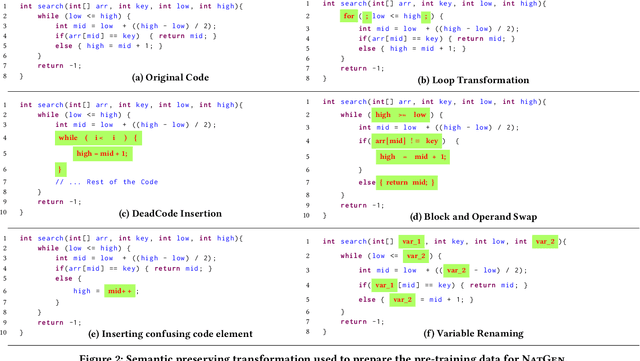
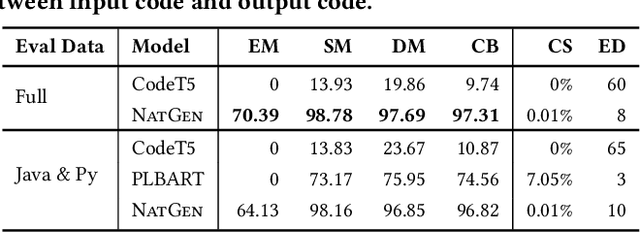
Abstract:Pre-trained Generative Language models (e.g. PLBART, CodeT5, SPT-Code) for source code yielded strong results on several tasks in the past few years, including code generation and translation. These models have adopted varying pre-training objectives to learn statistics of code construction from very large-scale corpora in a self-supervised fashion; the success of pre-trained models largely hinges on these pre-training objectives. This paper proposes a new pre-training objective, "Naturalizing" of source code, exploiting code's bimodal, dual-channel (formal & natural channels) nature. Unlike natural language, code's bimodal, dual-channel nature allows us to generate semantically equivalent code at scale. We introduce six classes of semantic preserving transformations to introduce un-natural forms of code, and then force our model to produce more natural original programs written by developers. Learning to generate equivalent, but more natural code, at scale, over large corpora of open-source code, without explicit manual supervision, helps the model learn to both ingest & generate code. We fine-tune our model in three generative Software Engineering tasks: code generation, code translation, and code refinement with limited human-curated labeled data and achieve state-of-the-art performance rivaling CodeT5. We show that our pre-trained model is especially competitive at zero-shot and few-shot learning, and better at learning code properties (e.g., syntax, data flow).
VELVET: a noVel Ensemble Learning approach to automatically locate VulnErable sTatements
Jan 13, 2022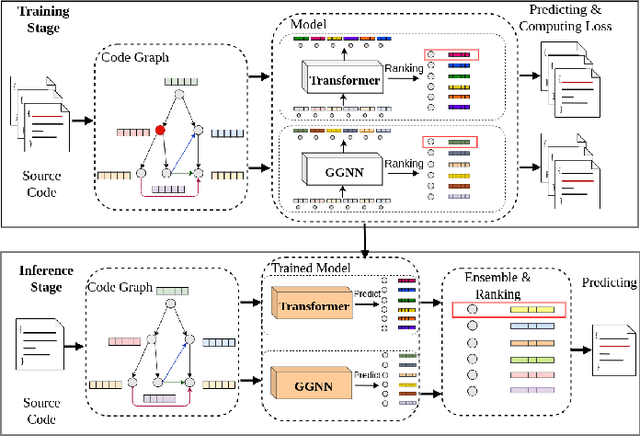
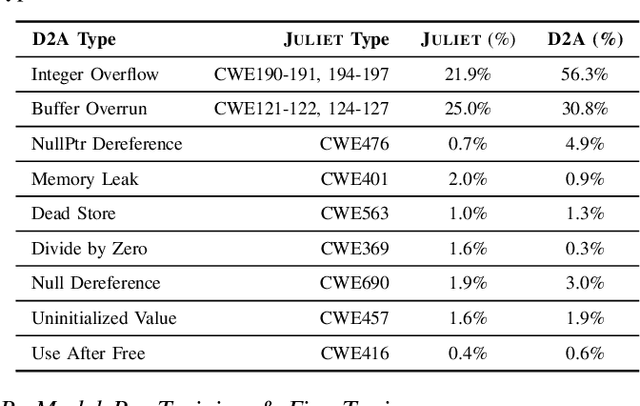


Abstract:Automatically locating vulnerable statements in source code is crucial to assure software security and alleviate developers' debugging efforts. This becomes even more important in today's software ecosystem, where vulnerable code can flow easily and unwittingly within and across software repositories like GitHub. Across such millions of lines of code, traditional static and dynamic approaches struggle to scale. Although existing machine-learning-based approaches look promising in such a setting, most work detects vulnerable code at a higher granularity -- at the method or file level. Thus, developers still need to inspect a significant amount of code to locate the vulnerable statement(s) that need to be fixed. This paper presents VELVET, a novel ensemble learning approach to locate vulnerable statements. Our model combines graph-based and sequence-based neural networks to successfully capture the local and global context of a program graph and effectively understand code semantics and vulnerable patterns. To study VELVET's effectiveness, we use an off-the-shelf synthetic dataset and a recently published real-world dataset. In the static analysis setting, where vulnerable functions are not detected in advance, VELVET achieves 4.5x better performance than the baseline static analyzers on the real-world data. For the isolated vulnerability localization task, where we assume the vulnerability of a function is known while the specific vulnerable statement is unknown, we compare VELVET with several neural networks that also attend to local and global context of code. VELVET achieves 99.6% and 43.6% top-1 accuracy over synthetic data and real-world data, respectively, outperforming the baseline deep-learning models by 5.3-29.0%.
Contrastive Learning for Source Code with Structural and Functional Properties
Oct 08, 2021



Abstract:Pre-trained transformer models have recently shown promises for understanding the source code. Most existing works expect to understand code from the textual features and limited structural knowledge of code. However, the program functionalities sometimes cannot be fully revealed by the code sequence, even with structure information. Programs can contain very different tokens and structures while sharing the same functionality, but changing only one or a few code tokens can introduce unexpected or malicious program behaviors while preserving the syntax and most tokens. In this work, we present BOOST, a novel self-supervised model to focus pre-training based on the characteristics of source code. We first employ automated, structure-guided code transformation algorithms that generate (i.) functionally equivalent code that looks drastically different from the original one, and (ii.) textually and syntactically very similar code that is functionally distinct from the original. We train our model in a way that brings the functionally equivalent code closer and distinct code further through a contrastive learning objective. To encode the structure information, we introduce a new node-type masked language model objective that helps the model learn about structural context. We pre-train BOOST with a much smaller dataset than the state-of-the-art models, but our small models can still match or outperform these large models in code understanding and generation tasks.
 Add to Chrome
Add to Chrome Add to Firefox
Add to Firefox Add to Edge
Add to Edge